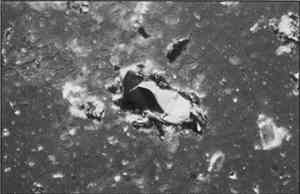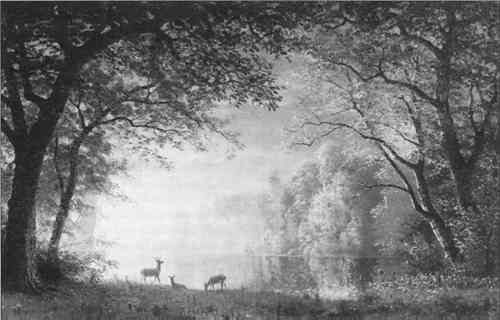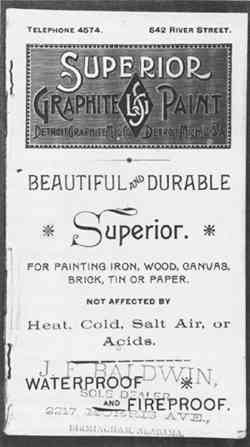BIERSTADT'S LATE PAINTINGS: METHODS, MATERIALS, AND MADNESSDARE MYERS HARTWELL
2 GRAPHITE GROUNDSTo find a layer of graphite oil paint in a painting is unusual to say the least, and leads to the question of its purpose. In the Cody version of The Last of the Buffalo, it plays no role in the intended appearance of the picture, covered over as it is by the thick lead-white layer. Curiosity led me to pursue the matter by inquiring among my colleagues for other examples of paintings with graphitelike ground layers, either by Bierstadt or other artists of the period. Eventually I was able to identify a small group of such works—all by Bierstadt—and to obtain samples of the ground layers on four of them: Rocky Mountain Sheep(fig. 3); Indian Sunset: Deer by a Lake(fig. 5); Weeping Oaks, Clear Creek, California(figs. 4, 6); and View of Point Lobos at Sunset (private collection). A view of Old Faithful (at the Kennedy Galleries, New York, in 1991) also has a graphite ground, and graphite grounds are suspected for a few other Bierstadt paintings
The samples were analyzed using light microscopy and powder x-ray diffraction. In each case the black ground was found to be a mixture of graphite with some clay and trace amounts of iron ores (Palmer 1989; see appendix). Of the group of paintings with graphite grounds, all those that can be dated fall between 18801 and ca.1888, which is the date traditionally assigned to The Last of the Buffalo because it was painted for the Paris Exposition of 1889. Unlike the Cody version of The Last of the Buffalo, however, none of these paintings has an interleaving white layer. The paint is applied directly on top of the graphite ground (see fig. 3). Moreover, because all four paintings are unlined, it was possible to see that the graphite coating had also been applied to the reverse of the canvas. All four paintings are still mounted on their original stretchers, which have wood panels inset between the crossbars (fig. 7). This is the type of stretcher that Bierstadt typically used on his paintings. In addition, Indian Sunset: Deer by a Lake and Old Faithful are mounted on panel-back stretchers with corner springs intended to provide automatic expansion and contraction of the stretcher in response to changes in humidity. Wright and Gardner patented this spring stretcher in 1875, and their labels can often still be found on the stretchers. Wright and Gardner stretchers were made both with and without the inset panels, but I have observed only the former on Bierstadt's paintings.
The question remains as to why Bierstadt used graphite paint as a preparation. Rocky Mountain Sheep is an exception in that the ground color does appear to provide luminosity to this night scene (Parkin and Huston 1985). In the other paintings, brightly colored paint covers the dark ground so that it plays no part in the design, and for the Cody version of The Last of the Buffalo, Bierstadt actually provided a light substrate for the paint by covering over the graphite with a second, lead-white preparation. Graphite in dry form was available from at least the early part of the 19th century, and commercially prepared graphite and linseed oil paint became a common product toward the end of the century. Companies manufacturing the paint include the Joseph Dixon Crucible Co. in Jersey City, New Jersey; the Atlantic Paint Company and the Elko Paint Co. in New York City; the Wisconsin Graphite Co. in Pittsburgh, Pennsylvania; the National Paint & Varnish Co. and the Sherwin-Williams Co. in Cleveland, Ohio; the United States Graphite Co. in Saginaw, Michigan; and the Detroit Manufacturing Co. in Detroit, Michigan. The earliest reference that I found to commercial graphite paint is a sales receipt dated Graphite paint appears to have been manufactured primarily as a protective coating for metal exposed to weather, but late-19th-century advertisements also recommend it for canvas, wood, brick, and paper (fig. 8). Its touted properties include durability, elasticity, and imperviousness to water, chemicals, gases, and climate changes. The 1895 advertisement reproduced from the Detroit Graphite Manufacturing Co. (Warshaw Collection) in figure 8 proclaims:
It may be assumed that the “canvas” the advertisements recommend waterproofing with graphite paint is for items such as tents, awnings, and tarpaulins. However, Bierstadt may have been aware of the claims made for graphite paint, as in the advertisement illustrated here, and decided to experiment with it as a protective coating for painting canvas. The fact that the coating appears on both sides of the canvas would support this theory. We know that Bierstadt was concerned with protecting the canvas on his paintings. The panel-back stretchers that he used throughout most of his career are evidence of this concern, and written confirmation also appears in one of his letters in the archives of the Corcoran Gallery. Making reference to a man named Volmering who appears to have been a restorer in New York, Bierstadt writes:
It does seem possible that Bierstadt was using graphite paint as a preparation and reverse coating to provide additional protection for the canvas against moisture and dirt. It is obvious that Bierstadt was both concerned and knowledgeable about the preservation of paintings, and in fact, the canvases, even extremely large ones, that he mounted on panel-back stretchers often still do not require lining after more than 100 years, testifying at least to the efficacy of panel-back stretchers. The question remains, however, as to why Bierstadt used a graphite priming layer on the Cody but not the Corcoran version of The Last of the Buffalo. I can only hypothesize that by the late 1880s he had determined that graphite paint was an inappropriate priming layer for oil paintings. He covered it over with a leadwhite preparation in what is believed to be the first version of the picture and abandoned it altogether for the Corcoran painting (Hartwell and Parkin 1999). In fact, the efficacy of graphite paint for any purpose appears to rely on many variables, including the type of graphite, the method of manufacture, and the presence of additives. Bierstadt used a paint made of crystalline, or “flake,” graphite, which does not readily mix with oil. Additives such as silica, iron oxides, or calcium carbonate were generally With this in mind, it is not surprising to discover that paintings with graphite grounds are generally reported to be sensitive to solvents and difficult to clean, and they have often suffered major damage. Indian Sunset: Deer by a Lake is one of the few paintings in this group that appears to be in relatively good condition. Mayer examined the painting in 1988 and found both the ground and paint to be exceptionally soluble (Mayer and Myers 1988). Although the records of the Yale University Art Gallery state that the painting was “cleaned and restored” in 1972, there is an old, yellowed varnish underneath a more recent synthetic varnish layer. The original varnish might never have been completely removed, and this might account for the painting's having escaped the damage suffered by the others. It is probable that Bierstadt had become aware of some of the problems with graphite paint by the time he began the Cody version of The Last of the Buffalo, which seems to be the last painting to contain a graphite ground layer. For example, many of the paintings with graphite grounds have wrinkling in the paint layer. This wrinkling probably occurred as the paint dried and suggests poor adhesion between the paint and ground layers. Bierstadt could have noticed this problem occurring during the approximately eight years in which he used graphite. Furthermore, paintings in which the design layer is applied directly over the graphite ground have probably darkened, as oil paint becomes more transparent with time. Whether Bierstadt was aware of this phenomenon is impossible to say, but it is tempting to suggest that his use of the interleaving white layer on the Cody picture indicates as much. Certainly by the time he turned to the Corcoran version of The Last of the Buffalo, he had abandoned graphite paint altogether. |





